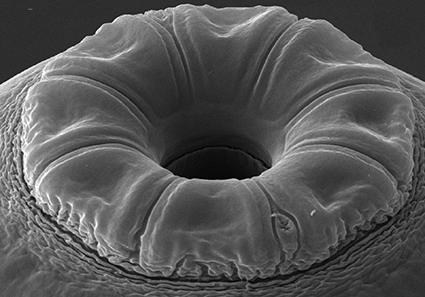Abstract
A new species of thelastomatid Leidynema bestium sp. n. is described from the hind gut lumen of the cockroaches Diploptera punctata (Eschscholtz, 1922) and Elliptorhina chopardi (Lefeuvre, 1966). The new species is characterized by a combination of morphological features: presence of lateral alae in both sexes with posterior margin of alae in females not ending in the shape of a spike; longitudinal striation of the anteriormost annuli in males; four male genital papillae, equatorial position of vulva. In the cladogram inferred from analysis of D2–D3 segment of LSU rDNA L. bestium sp. n. demonstrates a position independent of the Leidynema species with known sequences of this taxonomic marker near the basal node for this genus.
References
Altschul, S.F., Gish, W., Miller, W., Myers, E.W. & Lipman, D.J. (1990) Basic local alignment search tool. Journal of Molecular Biology, 215 (3), 403–410. https://doi.org/10.1016/S0022-2836(05)80360-2
Basir, M.A. (1956) Oxyuroid parasites of arthropods. A monographic study. 1. Thelastomatidae. 2. Oxyuridae. Zoologica, Stuttgart, 79 pp.
Cutillas, C., Guevara, D.C., Valero, A. & Gonzalez-Castro, J. (1985) Oogenesis in Hammerschmidtiella diesingi (Hammerschmidt, 1838) Chitwood, 1932 and Leidynema appendiculatum (Leidy, 1850) Chitwood, 1932 (Nematoda, Oxyuroidea). Revista Iberica de Parasitologia, 45 (3), 233–238.
Hominick, W.M. & Davey, K.G. (1973) Food and the spatial distribution of adult female pinworms parasitic in the hindgut of Periplaneta americana L. International Journal for Parasitology, 3(6), 759–764. https://doi.org/10.1016/0020-7519(73)90067-2
Kloss, G.R. (1966) Revisão dos nematoides de Blattaria do Brasil. Papéis avulsos do Departamento de Zoologia Secretaria da Agricultura São Paulo, 18 (16), 147–188.
Kumar, S., Stecher, G., Li, M., Knyaz, C. & Tamura, K. (2018) MEGA X: Molecular evolutionary genetics analysis across computing platforms. Molecular Biology and Evolution, 35 (6), 1547–1549. https://doi.org/10.1093/molbev/msy096
Lee, D.L. (1958) Digestion in Leidynema appendiculatum (Leidy, 1850), a nematode parasitic in cockroaches. Parasitology, 48 (3/4), 437–447. https://doi.org/10.1017/s0031182000021387
Leibersperger, Е. (1960) Die Oxyuroidea der europaischen Arthropoden. Gustav Fisher Verlag, Jena, 151 pp.
Leidy, J. (1851) A flora and fauna within living animals. Smithsonian contributions to knowledge, 5 (2), 1–67. https://doi.org/10.5962/bhl.title.56319
Nadler, S.A., D’Amelio, S., Fagerholm, H.-P., Berland, B. & Paggi, L. (2000) Phylogenetic relationships among species of Contracaecum Railliet & Henry, 1912 and Phocascaris Hùst, 1932 (Nematoda: Ascaridoidea) based on nuclear rDNA sequence data. Parasitology, 121, 455–463. https://doi.org/10.1017/S0031182099006423
Nunn, G.B. (1992) Nematode molecular evolution. Ph.D. Dissertation, University of Nottingham, Nottingham. Available from: https://ethos.bl.uk/OrderDetails.do?uin=uk.bl.ethos.334855 (accessed 4 March 2022)
Ozawa, S. & Hasegawa, K. (2018) Broad infectivity of Leidynema appendiculatum (Nematoda: Oxyurida: Thelastomatidae) parasite of the smokybrown cockroach Periplaneta fuliginosa (Blattodea: Blattidae). Ecology and Evolution, 8 (8), 3908–3918. https://doi.org/10.1002/ece3.3948
Pawlik, J. (1966) Control of the nematode Leidynema appendiculatum (Leidy) (Nemata: Rhabditida: Thelastomatidae) in laboratory cultures of the American cockroach. Journal of Economic Entomology, 59 (2), 468–469. https://doi.org/10.1093/jee/59.2.468a
Rolf, R.N., Barrett, J. & Perry, R.N. (2001) Analysis of responses of Leidynema appendiculatum to acetylcholine using electrophysiological techniques. Journal of Parasitology, 87 (4), 917–919. https://doi.org/10.1645/0022-3395(2001)087[0917:AOROLA]2.0.CO;2
Seinhorst, J.W. (1959) A rapid method for the transfer of nematodes from fixative to anhydrous glycerin. Nematologica, 4 (1), 67–69. https://doi.org/10.1163/187529259X00381
Singh, P.K., Rastogi, P. & Singh, H.S. (2014) Description of a new species of insect parasitic nematode, Leidynema (Schwenck, in Travassos 1929) (Thelastomatidae) from host Periplaneta americana of Meerut region, India. Journal of Entomology and Nematology, 6 (2), 32–41. https://doi.org/10.5897/JEN2013.0087
Spiridonov, S.E. & Guzeeva, E.A. (2009) Phylogeny of nematodes of the superfamily Thelastomatoidea (Oxyurida) inferred from LSU rDNA sequence. Russian Journal of Nematology, 17 (2), 127–134.
Swofford, D.L. (1998) PAUP*. Phylogenetic analysis using parsimony. Version 4. Sinauer, Sunderland, Massachusets. [unknown pagination] https://doi.org/10.1111/j.0014-3820.2002.tb00191.x
Thompson, J.D., Gibson, T.J., Plewniak, F., Jeanmougin, F. & Higgins, D.G. (1997) The CLUSTAL X windows interface: flexible strategies for multiple sequence alignment aided by quality analysis tools. Nucleic Acids Research, 25, 4876–4882. https://doi.org/10.1093/nar/25.24.4876
Travassos, L. (1929) Contribução preliminar á sistemática dos nematodeos dos arthropodos. Memórias do Instituto Oswaldo Cruz, 22 (5), 19–25. https://doi.org/10.1590/S0074-02761929000200004


